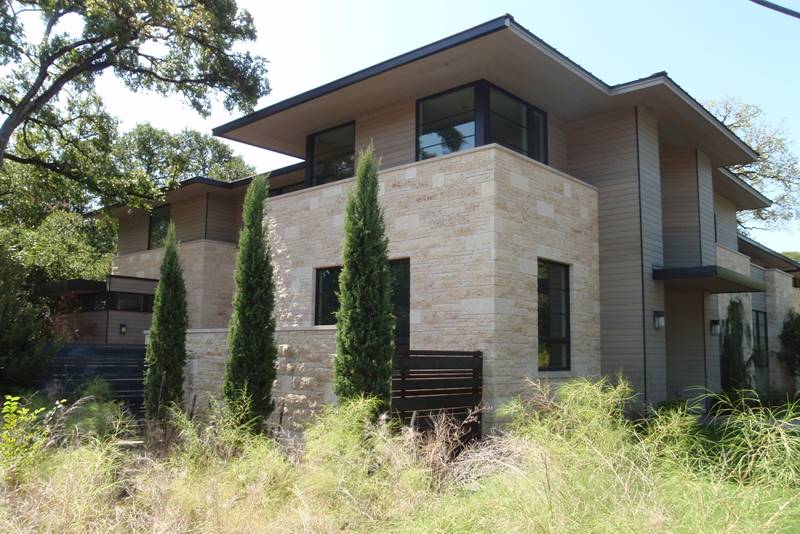The current housing market has many options for construction materials and design choices. This can make it hard to choose the right ones for a home. Homebuilders, buyers, and architects are increasingly interested in long-lasting, beautiful homes that provide comfort and align with principles of sustainable design. Yet it can be difficult to determine which combination of materials and approaches should be chosen to maximize efficiency without sacrificing quality and aesthetic appeal.
As the demand for eco-friendly homes grows, the focus has shifted toward sustainable materials that minimize waste, reduce long-term maintenance, and respect the natural environment. Truly sustainable homes consider not only the materials they are composed of but also the long-term impact of the building on the environment and its overall life cycle.
A house built with based materials that do not last a reasonably long amount of time is inherently not sustainable. Choosing wisely also means evaluating how raw materials are sourced, processed, and repurposed, since these decisions directly affect sustainability. So how does stone, one of the oldest natural resources used in construction, create a truly sustainable home?
Here are three important reasons to guide you in choosing stone as a core element for your eco-conscious project.
1. Stone: Natural and Sustainable
As a natural product of the earth, little to no extra materials are required to manufacture the materials. The only resources required to fabricate the stone for construction purposes are energy for transportation and shaping (of which, all materials require). Technological advancements in masonry have effectively minimized waste production and conserved resources. Additionally, there are a variety of different textures, colors, and characteristics of stone to suit whatever the home’s needs are.
2. Recyclable material
Another reason stone is an excellent choice lies in its recyclability. Many modern construction materials are difficult—or impossible—to recycle effectively. Synthetic siding, for instance, may end up in landfills after just a few decades. Stone, on the other hand, can be repurposed countless times without losing quality.
When a building eventually reaches the end of its life cycle, stone from walls, floors, or facades can be reused for roads, landscaping, new building projects, or even artistic installations. By giving stone a second or third life, builders reduce the demand for new natural resources, conserving energy and water that would otherwise be required to create new products.
This characteristic ties directly to reducing the overall impact on the environment. A truly sustainable house does not just serve one generation—it offers a legacy of responsible design. Using stone and other sustainable materials means that long after a home is remodeled or demolished, the core materials still serve a valuable purpose.
Imagine salvaging a stone fireplace from a 50-year-old home and reusing it as part of a garden pathway or patio in a new property. This type of lifecycle reuse is one of the hallmarks of sustainable design, ensuring materials maintain value well beyond their first use.
3. Natural stone is long-lasting and reliable
Durability is perhaps the most important factor when assessing whether something qualifies as a sustainable material. After all, the longer a home lasts, the fewer resources are needed to repair, replace, or maintain it. Stone excels in this regard and directly contributes to the overall sustainability of a building.
From flooring and walls to outdoor pathways and patios, stone withstands decades—if not centuries—of use. Compared to wooden floors, which can warp, rot, or fall victim to termites, stone remains resilient against many environmental stressors. Its ability to resist water damage makes it especially ideal for regions with heavy rainfall or humidity.
Because of its strength, stone reduces the need for repeated replacements, saving money and conserving natural resources. This characteristic makes it one of the best-performing sustainable materials on the market. Maintenance is minimal: most natural stone surfaces only require cleaning with a simple solution of water and mild soap. Unlike other natural materials, stone does not demand special treatments or harsh chemicals, which further lowers the home’s chemical footprint.
Enhancements such as weather-resistant finishes, sealants, and anti-slip coatings can extend the life of stone even further. These options ensure safety and comfort while aligning with sustainable design practices. For homeowners seeking both function and beauty, stone provides unmatched reliability while reinforcing the long-term sustainability of a building.
Expanding the Case for Sustainable Homes
While stone’s advantages are clear, it also serves as a reminder of what makes a material sustainable in the first place. Builders and homeowners should always evaluate:
- Durability – Does it last long enough to reduce the need for constant replacement?
- Recyclability – Can it be repurposed after its first life cycle?
- Environmental footprint – What is the material’s total impact on the environment, from production to disposal?
- Resource conservation – Does it minimize reliance on scarce natural resources?
Stone excels in all of these categories, standing alongside other sustainable materials such as reclaimed wood, recycled metal, and bamboo. However, unlike some options that may require heavy treatment, stone remains naturally strong, versatile, and highly environmentally friendly, offering builders and homeowners a practical solution with minimal ecological impact.
Real-World Applications
Homeowners can integrate stone into their houses in countless ways:
- Exterior walls and facades that resist weather and add timeless appeal.
- Flooring that outlasts other materials and requires little upkeep.
- Countertops that balance beauty with practicality.
- Outdoor features such as patios, retaining walls, and pathways that anchor landscaping designs.
By incorporating stone into these areas, you are not just adding elegance—you are embracing a material that reflects both history and future-oriented sustainable design.

